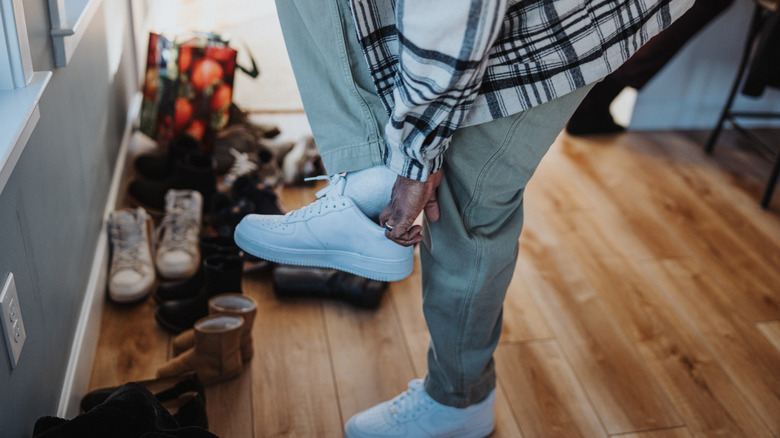The Hardwood Flooring Mistake HGTV's Mike Holmes Wishes People Would Stop Making
Hardwood is considered one of the most desirable flooring options out there, with unmatched warmth, character, and timeless beauty. Giving a space a stylish, high-end upgrade while still feeling cozy and approachable, hardwood floors are beloved for toeing the line between chic luxury and livable practicality. However, construction and renovation expert Mike Holmes, star of HGTV's "Holmes on Homes," says there's one major issue with hardwood floors that you need to consider before you start installing it in every room.
"Never put hardwood floors right at the front door, as you can ruin the wood when you bring in moisture from outside," Holmes said in a blog post for HGTV Canada. Especially in coastal locations or in climates dealing with lots of rain or snow, water outside means moisture you're bringing indoors with you. And sitting water on wood flooring means trouble (more on that later). In addition, any exterior entrance can be a very high-traffic zone for many families, meaning you also have to deal with extra potential floor damage like scratches and nicks from sand, dirt, mud, pebbles, and anything else that finds its way in on the bottom of your guests' shoes. So let's take a deeper dive as to why hardwood floors near an entry door are not the best choice if you want to keep them looking great, functioning well, safe for your family, and what to do to protect them if they're already installed.
Why hardwood floors and entryways don't always mix well
The crux of the issue with entryway hardwood floors is repeated exposure to outdoor elements and high foot traffic, each of which brings its own set of complications. "Wood is prone to moisture damage and can be marked and dented when you drop something," Mike Holmes says in his blog, Make It Right. Constant contact with water, loose particles, and heavy use is a recipe for damaged hardwood floors, which can cost a pretty penny to refinish or replace.
Even minimal exposure to water can cause discoloration in your wood floors, causing them to change color or acquire light or dark stains. The more moisture, the more damage, eventually leading to warping, buckling, cracking, and even unsafe mold growth in your hardwood floors, as well as the musty odor that goes along for the ride. Hardwood floors located in close proximity to an exterior entrance are prime candidates for moisture damage, which is why Holmes strongly advises against installing them there.
But in addition to serious water issues at an entry door, the secondary issue is the heavy traffic coming in with outdoor particles, such as dirt, sand, rocks, and other grit, stuck to their shoes. Some debris can get wedged inside shoe soles, causing damage with every step, while other loose particles can be dragged or pushed into the surface with contact from feet or furniture to scratch or dent the floors. Even sharp, pointy shoes like high heels can gouge the wood, so the more foot traffic in an area, the higher the risk of surface damage to your floors from the elements and usage. So if you don't already have them installed by your doors, you may want to take Holmes' advice and think twice.
For those with hardwood floor in the entry, take protective measures to avoid damage
These precautions are great if you're choosing new flooring, but what happens if you already have hardwoods in your entryway? Luckily, there are many protective measures you can take to prevent damage to your beautiful floors. The first line of defense starts on the exterior, with a high-quality doormat placed in front of your door. It's a visual cue for guests to wipe their feet before they enter, hopefully removing most of the damaging particles and moisture that are hiding on their shoes. Even without a formal wipe, the simple act of walking on a doormat is like a little broom across their soles. Next, it's essential to protect your floors with an interior mat or area rug within stepping distance of the door, preferably one with a waterproof or water-resistant underlayment. It will clearly designate that space as a safe zone for footwear and act as a physical barrier between shoes and the floor. From here, it's best to implement a no-shoes-in-the-house policy (at least with family) beyond your protective rug to significantly reduce the risk of damage, so be sure to provide a shoe rack or other clear, designated storage for yourselves and guests.
Finally, from a maintenance perspective, be sure to sweep or vacuum regularly to remove any debris that managed to make its way inside. Dry up wet shoe prints or drips immediately to avoid water damage. And when the day comes to refinish your hardwood floors, be sure to use a high-quality water-resistant coating like polyurethane varnish to protect the wood from all the potential dangers. Wood floors are meant to be lived on and loved, but taking measures to protect them will keep them in tip-top shape.


